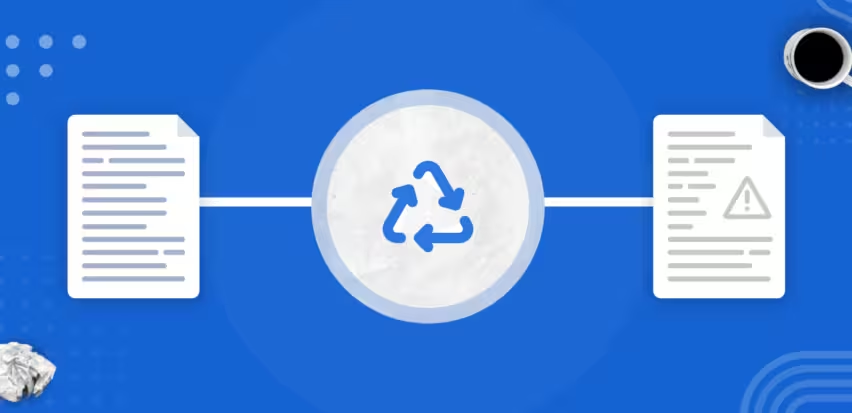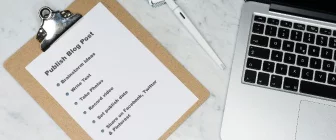
Rick breaks down how to spot spun content, why it’s still a problem in the age of AI, and what you can do to prevent it from slipping into your content strategy.
In the video above, Rick breaks down the still-relevant (and still risky) practice of spinning content — what it is, how to identify it, and how to prevent it from creeping into your content strategy. The transcript below captures the full video in Rick’s words, with slight paraphrasing for clarity and readability.
Transcript:
Hey everybody. Rick from Stellar here. Today I want to talk to you about spinning content: what it is, how to spot it, and, most importantly, how to avoid it.
With all eyes lately on AI-generated content, this age-old trick has kind of taken a back seat. But it’s one you need to be even more vigilant about.
What Is Spun Content?
Content spinning is the act of taking an existing article and rewriting it — changing the wording, using synonyms, restructuring sentences — without adding any information gain or real value. Then, it’s passed off as new content.
It’s not technically copying, but it basically is.
Why Be More Vigilant Now?
In the past, spinning content had to be done manually. A writer would pick a top-ranking article that fits what the client is looking for and rewrite it paragraph by paragraph, sentence by sentence, just reorganizing thoughts, swapping in synonyms, and calling it done. It was still time-consuming, but faster than writing from scratch.
Now, with AI, a simple prompt can spin existing content into something that looks completely unique, passes plagiarism checks, and, unfortunately, often passes client review.
In the worst cases, the spun content is a 1-to-1 match: the exact same subheads, the same order, the same thoughts in each section. It’s the same article using different words. That’s a direct spin, easy to find and bad for your website.
More sophisticated spinners use multiple articles, pulling ideas from several sources and stitching them together. This takes longer and is harder to spot, but it still lacks value. There’s no new information, no unique perspective, and nothing that reflects your business’s voice.
Is Spun Content Actually Bad?
Yes, it’s bad.
Even if it’s not technically plagiarism, spun content adds no new information or value for your audience. It adopts someone else’s perspective and ideas — ideas that may not align with your brand — and erodes trust with your audience.
Think about a user who just read the original article elsewhere, didn’t find what they were looking for, and now lands on your site, only to read the same thing again. That’s a terrible experience.
Why Do Writers Spin Content?
There are a few reasons.
1. Lazy Writers
This is the worst-case scenario. A lazy writer finds a way to make money with minimal effort. These are the bad apples you need to identify and remove.
2. Lack of Subject Knowledge
Sometimes, good writers are generalists and don’t have deep knowledge of your subject matter. If they’re not given a solid content brief that:
- Outlines how to approach the topic
- Defines the target audience
- Provides a clear information gain
- Distinguishes your angle from existing articles
- Lays out a strong section-by-section outline
…then the writer may resort to spinning. And at that point, the only question is how well they do it: a 1-to-1 spin or a stitched-together version from multiple sources.
3. Weak Content Briefs
Even when writers are given briefs, problems still arise if the briefs are weak. For example, a strategist might just review a couple of top-ranking articles, list out their sections, and build an outline based on that. If the writer follows that brief, the resulting content still ends up being a subtle version of spun content — different words, but the same ideas and structure.
4. Clients Who Over-Direct
Another way this happens is when clients fixate on a competitor’s article. They’ll say, “This article is great. It’s exactly what we want.” And whether they realize it or not, they’re pushing the writer to recreate it.
How to Spot Spun Content
Spotting it can be tricky. There are tools you can try — just search for “spun content detector” — but like AI detectors, they’re often unreliable.
What really works is human review.
Familiarize yourself with the top-ranking articles for your topic. If the piece you’re reviewing mirrors one of them — same structure, same core ideas, even if worded differently — that’s a red flag.
The biggest giveaway? Odd word choices.
Spun content often tries to avoid triggering plagiarism detectors, which flag repeated phrases. That forces the writer (or AI) to avoid using natural-sounding phrasing and instead use synonyms or awkward constructions. If you notice phrasing that seems just a little off or overly complicated when a simpler phrase exists, that’s a clue.
Prevention Is the Best Medicine
Preventing spun content starts with your content brief.
A strong brief should:
- Include a thoughtful, original outline
- Provide context about your brand’s point of view
- Identify information gain or differentiation
- Guide even a generalist writer to produce content that reflects your brand’s ideas and approach
Just because you operate in a crowded industry doesn’t mean your content should sound like everyone else’s. Every business does things a little differently and has its own take on what matters. Your content should reflect that.
Content marketing is a great example. Half of you might disagree with what I’m saying, the other half might agree or would approach things differently. There’s no shortage of perspectives, and those need to show up in your content.
Writers, especially freelancers, need guidance to reflect that. Train your internal writers and equip your freelance writers with the information they need. A solid content brief is your number one defense against spun content.
Final Thoughts
Finding your differentiation and information gain should be a pre-production task, not something you leave up to the writer. Generalist writers are great at communicating information, but they shouldn’t be expected to create your business’s stance or form your unique point of view.
Invest in strong content briefs. Done right, they’ll lead to content that’s not only unique, but unmistakably yours.
